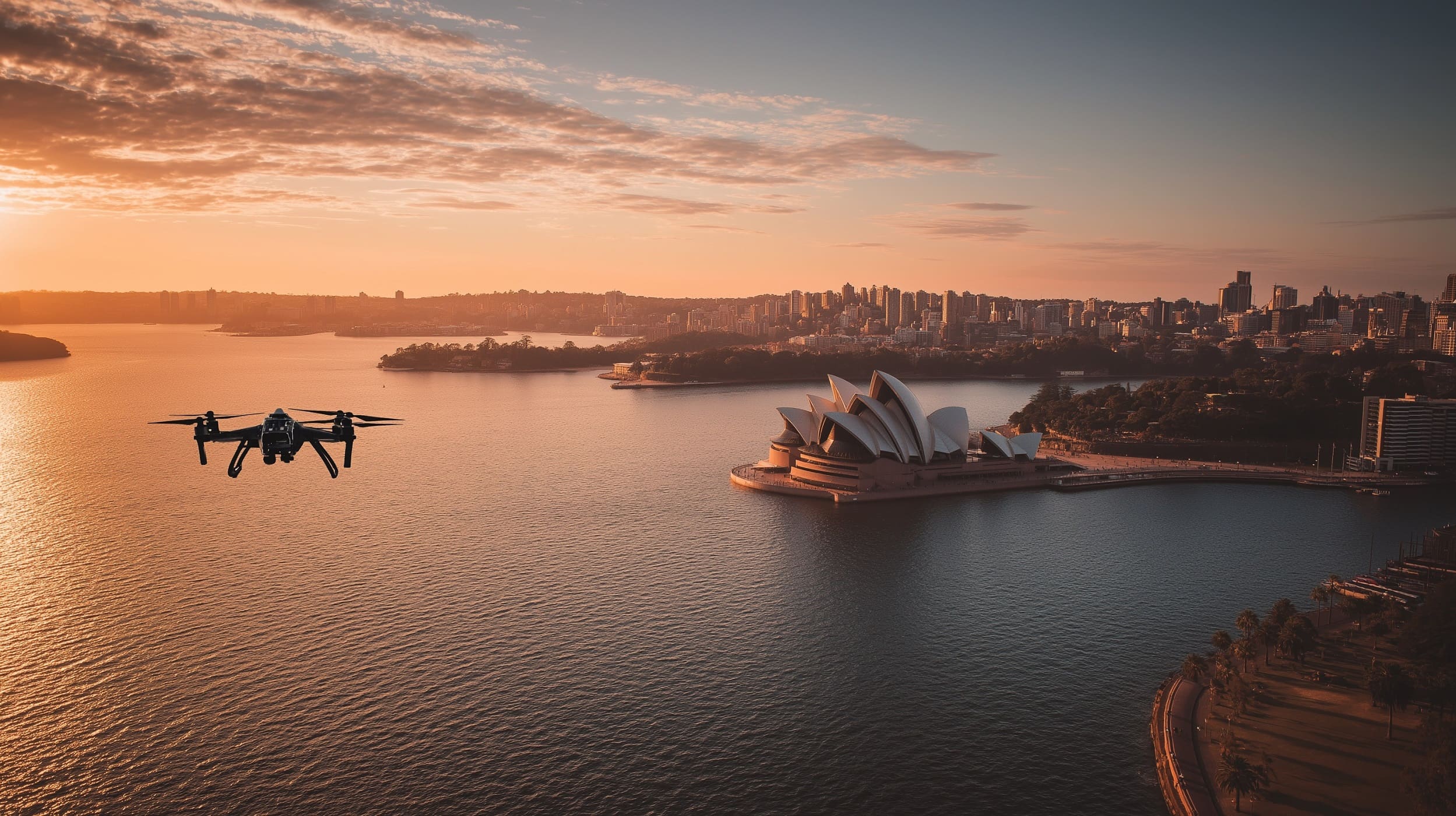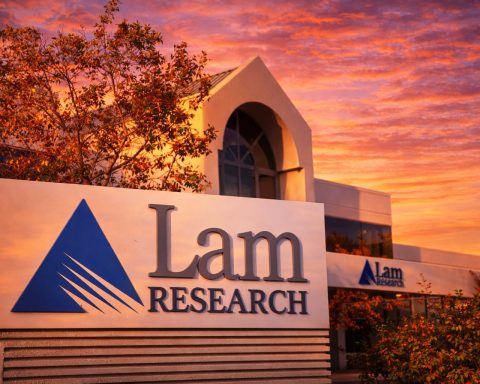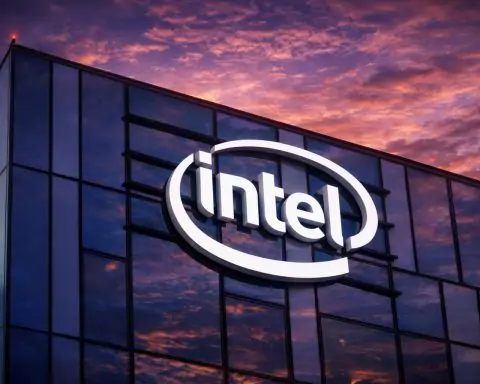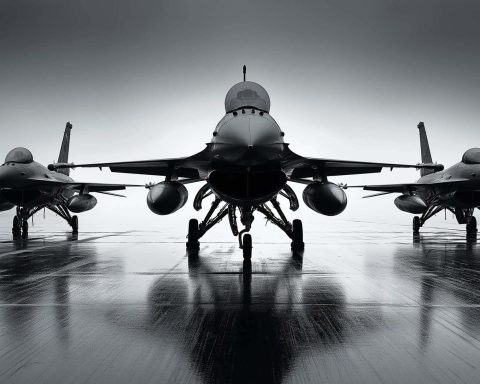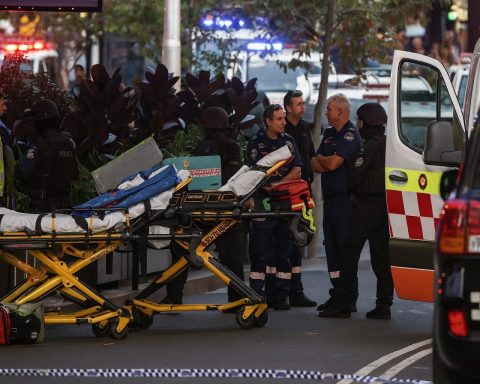- Drones in Sydney are regulated primarily by CASA nationwide under Part 101, with NSW state laws and local council bylaws adding extra restrictions.
- For recreational use, you don’t need a license or registration, but you must follow CASA safety rules including a maximum altitude of 120 meters, staying at least 30 meters from people, never flying over crowds, flying only in daylight with visual line of sight, and operating one drone at a time.
- Drones heavier than 250 grams must remain at least 5.5 kilometers from a controlled airport, while drones under 250 grams may operate within 5.5 kilometers up to 45 meters height, never in the airport’s boundary or flight paths.
- Commercial drone operations must be registered with CASA, with sub-2 kg drones requiring an Operator Accreditation and larger/advanced operations requiring a Remote Pilot Licence, and many jobs also require a CASA Remotely Piloted Aircraft Operator’s Certificate (ReOC).
- In New South Wales national parks, NPWS permits are required to launch, land, or operate a drone, with fines up to $3,300 for unauthorised flights and a rule to stay at least 100 meters away from whales and other marine mammals when permitted.
- Sydney Harbour and the CBD are designated restricted airspace (R405), requiring explicit CASA area approval to fly and prohibiting drone operations over the Opera House, Harbour Bridge, Circular Quay and Darling Harbour without authorization.
- Drones are prohibited at Sydney Olympic Park and other major venues by local bylaws, and the Major Events Act allows temporary no-fly zones during events like New Year’s Eve fireworks and large sports matches.
- City of Sydney and other councils restrict recreational drone flying on council land, often requiring a permit for commercial filming and banning drones in Botanic Gardens and Centennial Park.
- Drones near prisons and other critical infrastructure are illegal, with NSW penalties potentially including up to two years in prison for certain offenses.
- To stay compliant, pilots should use CASA‑approved safety apps (such as OpenSky, Drone Assist, or OK2Fly) and consult the new Local Rules Map (launched in late 2024) showing 7,610 areas managed by about 15 agencies, plus pre‑flight checklists and NOTAM alerts.
Sydney is a stunning city to film from above, but flying a drone here comes with strict regulations. In 2025, drone pilots face tighter rules, clearly defined no-fly zones, and hefty penalties if they break the law. Before you launch your drone over the Harbour Bridge or a local beach, make sure you understand who controls Sydney’s airspace and the 8 essential rules outlined below. We’ll cover everything from basic recreational limits to special commercial requirements, local council bylaws, and upcoming changes on the horizon. Read on for a complete guide to Sydney’s drone laws – you might be surprised by some of the forbidden zones and fines!
Who Regulates Drones in Sydney, Australia?
Drone use in Sydney is primarily regulated at the national level by Australia’s Civil Aviation Safety Authority (CASA). CASA sets uniform rules (under Part 101 of the aviation regulations) that apply across the country, including Sydney [1]. These cover fundamental safety requirements like altitude limits and keeping away from airports (detailed below). However, drone pilots must also follow state and local rules. In New South Wales (NSW) – Sydney’s state – there are additional restrictions set by state agencies and even local councils [2]. For example, NSW laws ban drones in certain parks and major event venues, and local councils can prohibit take-off or landing in their parks without permission [3]. In short, flying a drone in Sydney means complying with multiple layers of regulation: CASA’s nationwide rules first, plus any NSW state laws or council bylaws for the specific area you’re in.
Sydney’s airspace is busy and sensitive, so various authorities coordinate to keep it safe. Airservices Australia (the air traffic service) manages airspace and even operates a national drone detection system used in Sydney [4]. NSW Police enforce drone rules on the ground – for instance, during big events they actively patrol for illegal drone flights [5] [6]. The takeaway is that CASA’s rules are the baseline everywhere, but always check for local restrictions before you fly. The next sections break down those general rules and the Sydney-specific exceptions in detail.
Rules for Recreational Drone Use
If you’re flying a drone for fun (recreationally) in Sydney, you don’t need any license or registration – but you do need to follow CASA’s standard safety rules at all times [7] [8]. These rules apply equally across Australia. Below is a summary of the key regulations for recreational drone pilots:
- Maximum Altitude – 120 m: You must not fly your drone higher than 120 meters (400 feet) above ground level [9]. This keeps drones away from manned aircraft flight paths.
- Keep 30 m Away from People: Always keep your drone at least 30 meters away from other people (horizontally), and never fly directly over people [10]. This “30 m bubble” rule is to prevent injuries – even small drones can cause harm if they fall from the sky.
- No Flying Over Crowds or Populous Areas: You must not fly over populous areas like busy beaches, parks, sporting events or crowds [11]. If people cannot quickly move out of the way, the area is considered off-limits. (For example, a famous spot like Bondi Beach is effectively a no-fly zone when packed with visitors [12].)
- Daytime & Line-of-Sight Only: Only fly during daylight hours and keep your drone within visual line-of-sight (VLOS) at all times [13]. This means you must always be able to see the drone with your own eyes (not just through a camera feed or FPV goggles), and don’t fly into clouds, fog, or behind buildings/obstacles that block your view [14].
- One Drone at a Time: You may only operate one drone at a time – no simultaneous control of multiple UAVs [15].
- Avoid Hazardous Flying: Do not fly in a way that creates a hazard to another aircraft, person, or property [16]. You must give way to all manned aircraft. Also, do not fly near emergencies – it’s illegal to fly over areas like accident scenes, active bushfires, or rescue operations [17].
- Stay Clear of Airports: For safety, drones over 250 g are banned within 5.5 km of a controlled airport (one with a control tower) in Australia [18]. In Sydney this means you must not fly anywhere within 5.5 km of Sydney’s major airports (like Sydney Kingsford Smith Airport or Bankstown Airport) without approval. Drones 250 g or under have a slight concession – they may fly within 5.5 km of a controlled airport, but only up to 45 m high and never in the airport’s actual boundary or flight paths [19]. Regardless of drone weight, no drone can fly in the approach or departure path of a runway. And if you’re near a smaller aerodrome or helipad, you must be vigilant and give way to any aircraft (more on airports in a later section).
- Weight Limits: There is no specific weight limit for recreational drones (you can even fly large model aircraft for fun), but if your drone weighs more than 25 kg you need a special CASA approval to fly it at all [20]. The vast majority of consumer drones are under this threshold. Drones under 250 g are considered “micro” – they still must follow the rules, though CASA has relaxed some requirements for these tiny drones (e.g. allowances near airports as noted above).
Crucially, no license or training course is required to fly recreational drones in Australia [21]. As CASA states, if you’re only flying for sport or recreation, you don’t need a remote pilot license or even to register your drone (registration for hobby drones was proposed but is not in effect as of 2025) [22]. The assumption is that you’ll stick to the standard safety rules listed above. If you cannot stick to those rules – for example, you want to fly at night or above 120 m – then you’re no longer in the basic “recreational” category and would need special approvals. In general, Sydney hobbyists should err on the side of caution and always fly in safe, open areas away from people. Remember that busy urban locations or tourist attractions often present a combination of these restrictions (populous area, nearby heliports, etc.), making them unsuitable for casual drone flights.
Rules for Commercial Drone Operations
Flying a drone commercially (for work or business) in Sydney triggers additional legal requirements beyond the standard rules. CASA terms commercial use as operating a Remotely Piloted Aircraft (RPA) for hire or reward, and it comes with stricter rules on pilot qualifications, drone registration, and permissions. In short, if you fly your drone for work, you must register it and you must be licensed or accredited to operate it [23]. Here are the key regulations for commercial drone operations:
- Drone Registration: Every drone used for commercial purposes must be registered with CASA, regardless of its weight [24]. You register through CASA’s online system (myCASA), and registration needs renewal every 12 months. (There’s a small annual fee for larger drones, but drones under 500 g can be registered for free [25].) Flying a work drone without registering it is a serious offense – CASA can issue fines up to $16,500 for operating an unregistered drone commercially [26]. So, even if you’re using a tiny 300 g drone for your business (real estate photography, for example), you must register it before flying.
- Pilot Licensing vs Accreditation: Australia has a two-tier system for commercial drone pilots:
- Excluded Category (small drones) – If your drone is 2 kg or less, or you’re only flying over your own land, you fall under the “excluded RPA” category. You do not need a full Remote Pilot Licence, but you do need to obtain a CASA Operator Accreditation [27]. The operator accreditation is a quick online course/quiz (free on CASA’s website) that covers basic airspace rules and safety knowledge. You must be at least 16 years old to get accredited. Once you pass, CASA issues you an operator accreditation certificate valid for 3 years. This accreditation essentially takes the place of a license for small-drone operators in low-risk scenarios [28]. (Example: a wedding photographer using a DJI Mavic – ~1 kg – needs to register the drone and get the CASA accreditation, but not a full pilot license [29].)
- Licensed Category (large or advanced operations) – If your drone is over 2 kg, or you want to do higher-risk operations (like flying in more complex airspace, at night, etc.), you’ll need a Remote Pilot Licence (RePL) [30]. Obtaining a RePL involves formal training through a CASA-approved course and demonstrates a higher level of proficiency. In addition, commercial operations beyond the “excluded” basic scenarios usually require working under a CASA-approved Remotely Piloted Aircraft Operator’s Certificate (ReOC) [31]. A ReOC is essentially an organization-level certificate (like a drone operator’s license for a business) that entails having approved safety manuals, procedures, insurance, and a chief remote pilot responsible for operations. Many Sydney drone freelancers operate under someone else’s ReOC (for example, contracting with a licensed drone company) rather than holding their own – but either way, a ReOC is required for most advanced or larger-scale commercial jobs [32] [33].
- Operating Conditions: Importantly, all the standard safety rules (altitude limit, 30 m from people, VLOS, etc.) still apply to commercial flights unless you have a specific CASA authorization to break them [34]. In other words, having a RePL doesn’t let you fly over crowds or at night by default. To conduct operations outside the normal rules – such as night flights, flights above 120 m, beyond visual-line-of-sight (BVLOS), or flights over people – an additional CASA approval or exemption is required for each type of operation [35] [36]. For example, some Sydney drone operators have obtained approvals to fly at night with special lighting on the drone, or to inspect structures in the city using controlled safety procedures. These are handled case-by-case by CASA. For most commercial drone users sticking to straightforward jobs (real estate shoots, surveying, etc.), it means you operate under the same limits as recreational users (daytime, <120 m, etc.), just with the proper license and paperwork in place [37].
- Certifications and Insurance: In addition to CASA’s requirements, certain jobs or locations may require extra certification or permissions. For instance, to fly in the Sydney Harbour restricted airspace (discussed below), a commercial operator would need a CASA area approval even if licensed. Local authorities might require permits for take-off/landing on their land (more on that in the Local Rules section). Also, while not mandated by federal law, having public liability insurance is effectively essential for commercial drone work – many councils and clients in Sydney will ask for a $10–20 million liability insurance certificate before allowing drone operations on their site [38]. The City of Sydney, for example, requires a minimum $20 million coverage for any drone filming permit on council land [39]. Ensuring you have all necessary permits (e.g. a filming permit from council, or an NPWS permit for a national park shoot) and safety management plans in place is part of being compliant as a professional drone operator.
In summary, the bar is higher for commercial drone flying in Sydney. You must register your drone with CASA, obtain the appropriate pilot credentials (at least an Operator Accreditation for sub-2kg drones [40] or a Remote Pilot Licence for larger/complex operations [41]), and abide by the same safety rules unless you have specific exemptions. Sydney’s combination of busy airspace and local regulations means commercial operators often have to coordinate with multiple bodies – CASA for air approvals, local councils for land access, possibly Airservices for airspace notifications, etc. – especially if operating in the city or other sensitive areas. Next, we’ll explore those sensitive areas and no-fly zones you need to know about.
Key Restricted and No-Fly Areas in Sydney
Sydney has some heavily restricted airspace and “no-fly” zones for drones, due to its international airports, dense urban environment, and protected sites. Flying in the wrong place can get you in serious trouble. Below are the major restricted areas and rules specific to Sydney:
- Airports (5.5 km Exclusion Zones): As mentioned earlier, CASA prohibits drones heavier than 250 g from flying within 5.5 km of a controlled airport without approval [42]. In Sydney, this creates a large no-fly radius around Sydney Kingsford Smith International Airport (YSSY) in Mascot – covering much of the inner city and suburbs near the airport – and also around Bankstown Airport in the west. Even for micro drones 250 g or under, no drone may fly directly over or in the approach/departure path of an airport’s runways [43]. (Sydney’s runways have approach paths extending well beyond 5.5 km over Botany Bay and the city – these are definite no-go zones for drones.) Between 5.5 km and about 8.5 km out from a major airport, drones may operate at lower altitudes (under 90 m in certain outer areas) but it’s highly recommended to use a drone safety app to know exactly where these boundaries lie [44] [45]. Additionally, Sydney has many helipads and non-controlled aerodromes (e.g. hospital helipads in the CBD, Rose Bay seaplane base, Camden Airport on the outskirts). You can fly near these if you exercise extreme caution, but you must give way to any manned aircraft – if a helicopter or seaplane is approaching, you must immediately drop low and land your drone safely [46]. A good rule of thumb is to always stay well away from any active airfield or helipad unless you have specific permission. The bottom line: the airspace around airports is highly sensitive, and Sydney’s main airport essentially creates a broad exclusion zone covering much of the central city and eastern suburbs for average drone users.
- Sydney Harbour & CBD – Restricted Airspace (R405): One of the most important special restrictions is the Sydney Harbour controlled airspace. CASA has designated the airspace over central Sydney (including the Harbour area) as a restricted area (often referenced as R405A/B) where drones cannot fly without explicit permission. In fact, CASA explicitly warns that Sydney Harbour is a “no drone zone” for recreational pilots due to the high volume of low-flying seaplanes and helicopters and its inclusion in Sydney’s Class C controlled airspace [47]. This means iconic locations like the Sydney Opera House, Harbour Bridge, Circular Quay, and Darling Harbour are off-limits to drones unless you have a CASA area approval. Downtown Sydney and the surrounding harbor foreshore fall under this restriction [48]. A CASA bulletin in 2024 hammered this point home: “Drone operators should not be operating in Sydney Harbour as it is restricted airspace. It is an offence to operate a drone or other aircraft there without prior authorisation.” [49]. During major events like the Vivid Sydney light festival, authorities even set up drone no-fly zones on the north shore (covering popular lookout points like McMahons Point, Kirribilli, Cremorne Point, etc.) to deter any rogue drones [50]. Unless you are a fully licensed operator who has gone through CASA’s approval process for a specific flight (typically only granted for film productions or public safety operations), you should never attempt to fly in the Sydney Harbour or CBD area. This is one of the most tightly controlled urban airspaces in Australia. Indeed, a teenage drone pilot learned this the hard way – in one case CASA fined a pilot $1,440 for illegally flying in Sydney Harbour’s restricted airspace and within 30 m of people [51]. In short, leave the Harbour shots to the professionals with approvals – an unauthorized drone flight over the Opera House could cost you far more than the price of your drone in fines.
- National Parks and Wildlife Areas: New South Wales has strict rules against unauthorised drone use in national parks. In any NSW National Park (which includes areas in and around Sydney like Royal National Park, Ku-ring-gai Chase NP, Sydney Harbour National Park, etc.), you must obtain prior approval from NSW National Parks and Wildlife Service (NPWS) to launch, land, or operate a drone [52]. Recreational drone use is generally not allowed in these parks because of the potential impact on wildlife and visitor enjoyment [53]. To get approval, hobbyists have to apply in advance to the specific park office, and permission is rarely granted except for special circumstances. Commercial filming with drones in parks similarly requires a special permit under NPWS’s filming policy [54]. If you fly a drone in a national park without permission, you risk hefty state penalties – fines in NSW can reach $3,300 under the National Parks and Wildlife Act [55]. There are also wildlife protection rules: for example, if you do have permission to fly in certain coastal parks, you must stay at least 100 m away from whales and other marine mammals at all times [56] (disturbing wildlife is an offense). Bottom line: unless you’ve gone through the official permit process, treat all national parks and nature reserves around Sydney as no-fly zones for your drone.
- Sydney Olympic Park & Major Event Venues: Sydney Olympic Park, the site of stadiums and sporting facilities in western Sydney, is another specifically restricted area. Drones are prohibited at Sydney Olympic Park by local bylaws [57]. This is often extended to other major sports stadiums and event venues in NSW whenever events are on. In fact, NSW has a Major Events Act that allows authorities to declare temporary no-fly zones for drones over certain events (like big sports matches, concerts, New Year’s Eve celebrations, etc.) [58]. For example, during New Year’s Eve fireworks on Sydney Harbour or New Year’s at Darling Harbour, drones are banned and police actively enforce it. Similarly, large sporting events (e.g. NRL Grand Final in Sydney) will typically have an airspace restriction – flying a drone over a packed Stadium Australia or Sydney Cricket Ground without approval would violate both the CASA populous area rule and potentially special event restrictions. Always assume that any declared “major event” in Sydney comes with a drone ban unless you have official permission. These rules exist to prevent drones from crashing into crowds or interfering with broadcast helicopters. If you’re unsure, check CASA’s drone apps or event notices; they’ll often publish when special restrictions are in place.
- Public Spaces and Council Land: Even outside of the above categories, you need to be mindful of where you launch and land your drone in Sydney. Many public spaces like beaches, playgrounds, and council parks have local rules. CASA’s rules forbid flight over any populous area [59], which means if a beach or park is busy, you cannot fly over the gathered people. But beyond that, local councils often have bylaws that ban drone take-offs/landings on council-managed land without permission. For instance, the City of Sydney Council (which covers the CBD and many inner suburbs) does not allow recreational drone flying from any of its parks or open spaces – they outright “do not approve drone use for non-commercial purposes” on their land [60]. They only grant permits for drone use if it’s part of an approved commercial filming activity (with a licensed operator). Likewise, the Royal Botanic Gardens and The Domain in central Sydney (managed by a state Trust) explicitly prohibit recreational drones; they will only consider drone use for certain commercial shoots with a full application and licensed pilot [61] [62]. Other councils around Sydney have varying stances – some might allow hobby flying in an empty oval, others ban all drones in their parks. A new online map launched by the Australian government in late 2024 shows local drone rules for thousands of parks and sites, and it’s a great reference [63]. As a general guideline, always check local council websites or signage before launching in a public park. If a sign says “No Drones,” heed it. And if the area is crowded (like a busy Bondi Beach on a weekend), remember that CASA rules themselves make it illegal to fly there due to people, even if the council had no specific law [64].
- Prisons and Critical Infrastructure: While not unique to Sydney, it’s worth noting that drones are strictly banned around prisons in NSW. In fact, flying or even possessing a drone near a correctional facility is a criminal offense – NSW law provides for up to 2 years in prison for drone pilots caught near jails or juvenile detention centers [65]. This was introduced to combat attempts to smuggle contraband. So, obviously, do not fly near any of the prisons in the Sydney region (e.g. Long Bay Jail) – you could literally end up in jail for it. Likewise, drones are typically forbidden around military bases and other critical infrastructure. Sydney has several military sites (naval bases at Garden Island and HMAS Penguin, RAAF Richmond airbase, etc.) where defense regulations or restricted airspace apply – you cannot just fly over them. Many of these locations will appear as red zones in drone safety apps.
In summary, Sydney’s map is dotted with drone no-fly zones: large airport exclusion circles, a central city/harbour restricted block, national parks around the outskirts, and various local spots like stadiums, prisons, and government sites. Always plan your flight carefully. An easy way to check is to use one of the CASA-verified apps (discussed later) – they incorporate these zones and can tell you if your intended location is legal. When in doubt, assume you cannot fly over important landmarks or crowded public areas in Sydney without special permission. Staying in the green zones (open fields well away from airports and people) is the safe bet for hobbyists.
Penalties for Violating Drone Laws
Breaking drone laws in Sydney (or anywhere in Australia) can lead to severe penalties – ranging from fines, to losing your drone license (if you have one), up to criminal charges in the worst cases. Both CASA and NSW authorities have shown little tolerance for unsafe drone flying, especially in the city. Here’s what you risk if you don’t obey the rules:
- Fines (Infringement Notices): CASA can issue on-the-spot fines for breaches of the drone safety rules. Typically, these fines are up to $1,650 per offense [66]. Each violated rule can count separately. For example, if you flew your drone 𝟭) in restricted airspace, 𝟮) over people, and 𝟯) out of line of sight, that’s multiple offenses and could mean multiple fines. It’s not uncommon to see total fines in the few thousand dollars for a single misguided flight. CASA officers and the police can investigate incidents (they often get reports from the public or use drone detection systems [67]) and decide on enforcement. If you receive an infringement notice, it will outline the offense and the fine amount [68], and you’ll be expected to pay by a deadline.
- Serious Offenses – Higher Fines and Prosecution: For more serious or deliberate breaches, CASA can take you to court. If prosecuted and convicted, the penalties jump significantly – fines up to $16,500 can be imposed by a court [69]. In addition, the court can impose other orders like prohibiting you from flying for a period. Jail time is also possible in extreme cases. Notably, if your drone endangers a manned aircraft or interferes with aviation, Australian law provides for up to 2 years imprisonment [70]. An example would be flying in the flight path of an aircraft taking off, causing a near-miss – that’s treated very seriously. While jail is rare, it’s on the books for worst-case scenarios (and as mentioned, state laws like the prison contraband law carry their own prison terms). Generally, CASA will pursue prosecution if someone refuses to pay fines or has a pattern of dangerous flying [71] [72].
- License or Accreditation Cancellation: If you hold a drone license (RePL) or accreditation, CASA can suspend or cancel it if you violate rules. They can also cancel your drone’s registration [73]. This means you’d be grounded from any legal flying. For certified operators, an infringement might also come with restrictions on your ReOC or requirements to retrain. Essentially, your privilege to fly can be taken away if you prove to be irresponsible or unsafe.
- State and Local Penalties: On top of CASA’s actions, remember that states and councils might impose their own fines. In NSW, for instance, flying in a national park without a permit can land you with a $300–$3,300 fine (depending on the offense) under NPWS regulations [74]. If you violate a council’s bylaw (say a council law against drones in a certain park), rangers could issue fines or evict you from the area. And as discussed, flying near NSW prisons can lead to criminal charges with up to 2 years jail [75] – that’s enforced by state police, not CASA. Also, if your drone use violates privacy laws or injures someone, you could be liable under civil or other criminal laws (e.g. a charge of negligence or nuisance). In one notorious Sydney case, a drone crashed into the Harbour Bridge and the operator was fined around $850 and faced potential charges for endangering traffic [76]. The web of potential penalties is broad.
- Notable Enforcement Examples: To give a sense of how rules are enforced: CASA has fined recreational pilots in NSW for things like flying over wedding guests (“hazardous flying” – $900 fine) [77], buzzing too close to people at a beach, and entering restricted zones (the Sydney Harbour incident at $1,440 fine we mentioned). During Sydney’s Vivid Festival 2024, police publicly warned that any drone found in the no-fly zone would be confiscated and the operator fined on the spot [78] [79]. They were actively scanning the skies for rogues. The message is clear – the authorities do monitor and they will penalize you if you break the rules. With many eyes on the sky (including members of the public who can report unsafe flying via CASA’s website [80]), getting away with illegal drone flights in Sydney is increasingly unlikely. It’s much cheaper and smarter to fly legally!
To sum up, the penalties range from a slap-on-the-wrist fine to life-changing consequences. Most commonly you might face a fine in the order of $1,000–$2,000 for a mid-level violation. But if you do something very dangerous or blatantly illegal, you could be taken to court for a larger fine or even face criminal charges in NSW. All drone pilots should consider these stakes. The good news is that by following the rules and using a bit of common sense, you’ll never have to worry about penalties – they’re easily avoided by responsible flying.
Local Council Rules and Notable Cases in Sydney
Sydney is governed by multiple local councils (City of Sydney, North Sydney, Waverley, Parramatta, etc.), and many have introduced their own rules for drone usage on land they manage. These rules mostly affect where you can take off and land your drone, especially for recreational flying, as well as permitting requirements for commercial filming. Let’s break down the local landscape:
- Council Land and Parks: Generally, if you are on council-owned land (parks, beaches, sports fields), you may need the council’s permission to use a drone there – even if CASA’s rules wouldn’t otherwise prevent the flight. For example, the City of Sydney Council explicitly states that any take-off or landing of a drone on City of Sydney land for commercial purposes requires council approval, obtained via a filming/photography permit [81] [82]. They require the operator to be CASA-licensed (RePL) and have insurance, and even then, flights are subject to strict safety plans [83] [84]. Importantly, City of Sydney does not allow recreational drone use on its land at all – if you’re just a hobbyist, they won’t grant you permission to use their parks [85]. In practice, this means you can’t launch your drone from places like Hyde Park, the Domain, or any city playground without breaking a bylaw, even if you keep 30 m from people. Other councils have similar rules: for instance, North Sydney Council (across the harbour) and Waverley Council (which includes Bondi Beach) require permits for any commercial drone filming and typically discourage or ban recreational flying in busy public areas. Always check the specific council’s website for “Drone Policy” or “Filming Permit” information for the location you plan to use. Some councils may have designated areas or times where model aircraft can fly, but many simply treat drones as a potential nuisance and forbid their use without prior approval.
- Notable Council Restrictions: Certain landmark areas around Sydney are managed by special authorities that have their own drone rules:
- The Sydney Harbour Foreshore Authority/Property NSW manages spots like The Rocks, Darling Harbour, and Barangaroo – they usually require permits for any filming and do not allow random drone flights due to safety and privacy of visitors.
- The Royal Botanic Garden and Centennial Parklands each have policies banning recreational drones. As noted, the Botanic Gardens Trust will only consider drone use for approved commercial projects, with extensive documentation [86] [87]. Centennial Park (a large park in the eastern suburbs) similarly prohibits drones unless specifically authorized for events.
- Beaches: Sydney’s famous beaches are under local councils (e.g. Bondi and Bronte under Waverley Council, Manly under Northern Beaches Council). These councils often have by-laws or rangers enforcing no drones when beaches are patrolled and crowded, for public safety. For instance, Waverley Council has signage at Bondi Beach advising that drones are not to be flown over the beach. Even if a council doesn’t have a written drone policy, remember the CASA populous area rule bans flights over sunbathing crowds anyway [88]. Some beachside councils might allow off-peak flying (e.g. very early morning when beaches are empty) but it’s wise to seek clarification or permission.
- Obtaining Permits: If you do need to fly in a council area for a legitimate reason (say, you’re a filmmaker with a project in a city park), be prepared to go through a permit process. Typically, you’ll need to apply days or weeks in advance, provide proof of your CASA credentials (RePL and ReOC details), a detailed flight plan and risk assessment, and proof of insurance coverage [89] [90]. Councils may impose conditions like having spotters to keep people away, specific time windows for flight (often very early when public are few), and fees for using the space. An example is North Sydney Council’s filming guidelines, which allow drones in low-impact shoots but require the pilot to be CASA-certified and the area to be controlled during flight [91]. Spontaneous drone flying in council parks is generally not allowed in metropolitan Sydney. One notable case was a few years ago when a wedding photographer attempted to use a drone in a Botanic Garden wedding shoot without permission – rangers intervened and CASA was notified, leading to an investigation. The lesson: in Sydney, if you see a beautiful park or backdrop, you can’t just fly there on a whim; you need to do homework with the land owner.
- Enforcement by Councils: While CASA handles the aviation side, councils can enforce trespassing or nuisance laws. They might call local police or issue fines if you violate their regulations. However, many councils rely on education – rangers may approach and inform drone users of the rules. In egregious cases (like a drone harassing wildlife or crowds in a park), council rangers will certainly escalate the matter. For instance, during New Year’s Eve at Sydney Harbour, not only CASA but city council officials and police combine efforts to watch for drones, and they will confiscate devices launched from public areas. In 2023 NYE, Sydney media reported that several drones were seized by police around the harbour foreshore where flying was banned for the event. So, there is active enforcement when it counts.
- Notable Sydney Drone Incidents: Beyond those we’ve already mentioned (Harbour fines, etc.), Sydney has had a few high-profile drone incidents that serve as cautionary tales. A well-known one was when a drone crashed into the Sydney Harbour Bridge in 2017, narrowly missing vehicles – the operator was later identified and fined, and it sparked calls for even tougher rules [92]. Another was when a drone pilot flew over a live sporting event (a soccer stadium) and was quickly tracked down; CASA issued penalties for breaching populous area rules. There have also been cases of tourists flying drones near airports – at one point a drone was spotted on final approach path to Sydney Airport, which prompted a temporary halt of some flights and a police search (the operator was not found, but it caused a scare). Each time these incidents happen, authorities ramp up public awareness campaigns. CASA’s “Know Your Drone” initiative frequently cites Sydney examples in their materials, saying essentially “don’t be that person who shut down an airport or got fined big $$$ – know the rules.”
In essence, Sydney’s local rules require drone pilots to be extra diligent about where they take off and land. Even if you’re following CASA’s flight rules, you could be trespassing or breaching council by-laws. The safest approach for recreational flyers is to stick to unofficial “approved” flying sites – there are model aircraft clubs and some open fields (outside populated areas) where drones are commonly flown with council tolerance. For commercial operators, doing the legwork with permits is just part of the job in Sydney. And with the number of drone incidents that have made news, you can bet that both officials and residents in Sydney are alert to rogue drones. Always err on the side of caution and courtesy with the local community – it will keep you out of trouble.
Tools for Checking Legal Airspace (Apps and Guidelines)
Given the patchwork of no-fly zones and regulations in Sydney, one of your best allies is technology. There are several official mobile apps and online maps that make it much easier to determine where you can and cannot fly your drone. Before every flight, Sydney drone pilots are strongly advised to consult these tools. Here are the key resources and how to use them:
- CASA-Verified Drone Safety Apps: CASA has approved a list of drone safety apps (available for free) that use location-based maps to display airspace restrictions in real time. Popular ones include OpenSky (by Wing/Google), OpenSky (Wing’s app available on web and mobile), Can I Fly There? (original CASA app, now integrated into others), OK2Fly, Drone Assist, and others [93] [94]. These apps show your GPS location and overlay all the relevant airspace information: controlled airspace, restricted zones, airport 5.5 km circles, heliport buffers, etc. For example, if you open OpenSky in central Sydney, it will clearly show the Harbour exclusion zone and the Sydney Airport radius in red. CASA explicitly recommends using one of these apps before each flight to check your location [95]. They are updated with the latest data, so they’ll also show temporary restrictions (like a major event no-fly zone) when applicable. In Sydney, a CASA-verified app is practically a must-have – it’s the quickest way to know if that park or beach you’re at is clear or falls under an exclusion. Some apps even provide warnings like “You are in controlled airspace – flight not permitted” if you’re about to take off in a restricted spot.
- New Local Rules Map: In late 2024, the Australian government launched a digital map of local drone rules that covers things like national parks, marine parks, and correctional facilities [96]. This is part of the “drone rule digitisation” initiative. The first release of the map shows 7,610 areas managed by about 15 agencies where local restrictions apply [97] – for example, it highlights all the national parks (where drones require permits) and prisons (where drones are banned) across the country. This map data is being integrated into the CASA-approved apps, meaning the apps will not only show airspace rules but also ground restrictions. So, as this rolls out, you’ll see in-app indications like “No take-off – national park” or “Drone banned – prison” for certain locations. You can also view the map via the web through the official drones.gov.au site [98]. This is a fantastic development because previously pilots had to manually research council websites; now a lot of that info is at their fingertips. Always ensure your app is updated to get these new local layers.
- Pre-Flight Checklist: Apart from digital tools, CASA provides guidelines on what you should check pre-flight. Key items include: weather conditions (don’t fly in high winds or poor visibility), your drone’s condition (battery, firmware, etc.), and that you have any required approvals (like CASA waivers or landowner permission). CASA’s “Know Your Drone” site has a handy checklist and FAQ. In Sydney’s context, add to your checklist: “Have I checked for any local Council or NPWS restrictions at this site?” Often a quick Google search of the park name + “drone” can reveal if others have reported it as allowed or not. When in doubt, contact the land manager.
- Real-Time Notifications: When flying in Sydney, keep an ear on any NOTAMs (Notices to Airmen/Airmen) that might be issued for drones. For example, during VIP visits or special events, there might be a NOTAM establishing temporary restricted airspace. Some advanced drone apps and DJI’s GEO system will notify you if a flight restriction is active (e.g., DJI drones won’t take off near airports or in NFZs unless unlocked with permission). Make sure these features are enabled on your drone.
- Education Resources: CASA’s “Know Your Drone” initiative (knowyourdrone.gov.au) is a one-stop hub for rules and has links to the apps, quizzes, and latest news. They even have a quiz to test your knowledge of the rules – a great way to ensure you haven’t missed anything. There are also community groups (like local Facebook groups or forums) for Sydney drone pilots where people share tips on safe locations to fly and heads-up about any enforcement activity. While not official, those can be valuable for local insight (e.g., which secluded beach is okay on a weekday morning, etc.). Just remember community advice doesn’t override official rules.
In summary, before you fly in Sydney, always “Check the map, check the app.” Taking 2 minutes to verify your airspace and local restrictions can save you from a potentially illegal flight. The combination of CASA’s verified apps and the new comprehensive local rules map means there’s really no excuse for stumbling into a no-fly zone. Fly with knowledge and you’ll fly safely – and keep both your drone and your wallet intact.
Upcoming Changes and 2025 Legislative Updates
Drone regulations are continually evolving, and 2025 is expected to bring further changes as authorities adapt to new technology and increased drone traffic. Here are some anticipated updates and trends on the horizon that could affect Sydney drone operators:
- Remote ID Requirements: One big change looming globally is Remote Identification (Remote ID) for drones – a system where drones broadcast their identity and location. While countries like the US have started requiring Remote ID, Australia has not mandated Remote ID yet as of 2025 [99]. However, Australia is actively exploring it. CASA released a discussion paper on Remote ID and is developing a policy on how to implement it [100]. The Aviation Green Paper (2024) and CASA’s RPAS roadmap suggest that by the late 2020s, drones in Australia will likely be required to have Remote ID transmitters [101] [102], especially for flights in urban areas like Sydney. This means in a few years, your drone might need to broadcast who you are and where you’re flying to a national network. For now, no action is needed (and no Australian drones are broadcasting ID yet except voluntarily), but operators should stay tuned – once standards are set, larger drones may need hardware upgrades or add-ons to comply.
- Drone Registration for Recreational Pilots: Earlier, we noted that hobbyist drones don’t need registration currently. CASA had actually planned to introduce mandatory registration for recreational drones over 250 g (along with an online education test) around 2022-2023, but this was postponed by the government [103]. The program was put on hold to reconsider cost and implementation. In 2025, it’s possible this plan will be revisited. Many expect that Australia will eventually bring in hobby drone registration (as is already done in the UK, EU, etc.) to improve accountability. So, don’t be surprised if within the next year or two, Aussie recreational pilots are asked to register their drones and maybe complete a short safety course online. If it happens, CASA will announce it widely and likely make the process simple via the “myCASA” portal.
- Advanced Air Mobility & New Airspace Integration: Sydney could see drone deliveries and air taxis become more common in coming years. Google’s Wing has been trialing drone deliveries in Canberra and Logan (QLD) successfully, and they have hinted at expanding operations [104]. While there’s no public drone delivery in Sydney’s dense areas yet, it could launch in outer suburbs in the near future. The government is supporting these innovations through the Emerging Aviation Technology Partnerships program, which means they’re working on how to safely integrate them. Practically, this could lead to the development of designated drone corridors or more automated air traffic management (UTM) in Aussie cities. CASA is already trialing Automated Airspace Authorisations in some locations (digital systems for quick permission near airports) [105]. As these systems roll out, licensed operators in Sydney might be able to get faster approvals to fly in certain restricted airspace via an app. For recreational users, the immediate impact is minimal, but in the long term the skies will get more organized. We might see, for example, specific altitude layers for commercial delivery drones vs hobby drones, electronic conspicuity requirements, etc. It’s an evolving space – the rules in 2025 won’t be the same as those in 2030.
- Legislative Reviews: The Australian government is working on an Aviation White Paper (due 2024-25) that includes drone policy. Issues being discussed include privacy, noise, and safety. There’s also ongoing discussion at the state level about empowering local law enforcement more in drone incidents (to date, CASA leads most enforcement). NSW in particular has shown it’s willing to legislate on drone matters (e.g., the prison ban law). We could see NSW considering drone-related provisions for privacy (for instance, making it an offense to film people in backyards with a drone – currently handled by general laws). While nothing concrete is law in 2025 on that front, drone pilots should keep an eye on NSW Parliament for any new bills.
- Public Education and Licensing Changes: CASA continuously refines how pilots get qualified. In 2024, CASA updated some regulations to clarify exceptions for sub-250g drones and to streamline licensing [106]. There’s talk of introducing a single online platform for all drone operators to log flights, report incidents, etc., to improve compliance. If you’re a RePL holder, expect periodic changes in the syllabus or renewal requirements as technology advances. For example, CASA introduced a new “extended visual line of sight” (EVLOS) authorization recently, bridging the gap between VLOS and BVLOS – we might see more of such categories to allow expanded operations under controlled conditions [107].
- Urban Drone Highways? Sydney’s future might include designated routes for drones (like along rivers or over roads). There have been proposals to use parts of Sydney’s low-altitude airspace in a coordinated way to allow more routine drone operations (for deliveries, surveys, etc.) without conflict. While this is still experimental, the infrastructure is being prepared now. The local drone rules map and digital tools being introduced are foundational steps toward a world where drones can automatically know where to fly. By 2025’s end, we don’t expect any dramatic new “drone highways” in operation yet, but the foundational regulatory pieces (like Remote ID and UTM trials) are being put in place.
In conclusion, drone laws are trending toward tighter integration and oversight. For Sydney pilots in 2025, the day-to-day rules remain as covered in this report. But changes such as Remote ID, mandatory hobbyist registration, and more automated flight clearance systems are likely on the way. The best advice is to stay informed: regularly visit CASA’s “Know Your Drone” website, subscribe to CASA’s newsletters [108], or join local UAV clubs to hear about rule changes. Sydney is poised to be at the forefront of the drone revolution (it’s a major city with high drone interest), so any new policies will certainly impact Sydney flyers early. By keeping up with the law and embracing new requirements proactively, you’ll ensure you can continue to enjoy flying in this amazing city legally and safely as the landscape evolves. Safe flying!
Sources:
- Civil Aviation Safety Authority (CASA) – Drone Safety Rules (updated Oct 2024) [109] [110]
- CASA – Enforcement and Penalties for Drone Breaches [111] [112]
- CASA – Flying Near Airports (drone exclusions around aerodromes) [113] [114]
- CASA – “Stay safe, leave your drone at home” (Sydney Harbour restrictions, May 2024) [115] [116]
- Drones.gov.au (Australian Govt) – State & Local Rules (NSW parks, events, etc.) [117] [118]
- NSW National Parks (NPWS) – Drone Policy (permits required for parks) [119] [120]
- City of Sydney Council – Drone Guidelines (permit requirements on council land, 2025) [121] [122]
- TS2 Tech “Australian Drone Laws 2025 – Complete Guide” (Summary of CASA rules and upcoming trends) [123] [124]
- Australian Photography – News on NSW Prison Drone Ban (2018 law, 2-year jail) [125]
- ABC News – “Drone pilot fined for flight in Sydney Harbour” (enforcement example) [126]
- CASA “Know Your Drone” – Recreational Drone Rules Summary [127] [128]
- CASA-Verified Drone Safety Apps – Official list (e.g. Wing’s OpenSky) [129] [130]
References
1. www.drones.gov.au, 2. www.drones.gov.au, 3. www.drones.gov.au, 4. www.casa.gov.au, 5. www.casa.gov.au, 6. www.casa.gov.au, 7. www.casa.gov.au, 8. www.casa.gov.au, 9. www.casa.gov.au, 10. www.casa.gov.au, 11. www.casa.gov.au, 12. ts2.tech, 13. www.casa.gov.au, 14. www.casa.gov.au, 15. www.casa.gov.au, 16. www.casa.gov.au, 17. www.casa.gov.au, 18. www.casa.gov.au, 19. www.casa.gov.au, 20. www.casa.gov.au, 21. www.casa.gov.au, 22. ts2.tech, 23. www.casa.gov.au, 24. ts2.tech, 25. ts2.tech, 26. ts2.tech, 27. ts2.tech, 28. ts2.tech, 29. ts2.tech, 30. ts2.tech, 31. ts2.tech, 32. ts2.tech, 33. ts2.tech, 34. ts2.tech, 35. ts2.tech, 36. ts2.tech, 37. ts2.tech, 38. www.cityofsydney.nsw.gov.au, 39. www.cityofsydney.nsw.gov.au, 40. ts2.tech, 41. ts2.tech, 42. www.casa.gov.au, 43. www.casa.gov.au, 44. www.casa.gov.au, 45. www.casa.gov.au, 46. www.casa.gov.au, 47. ts2.tech, 48. ts2.tech, 49. www.casa.gov.au, 50. www.casa.gov.au, 51. www.abc.net.au, 52. www.nationalparks.nsw.gov.au, 53. www.nationalparks.nsw.gov.au, 54. www.nationalparks.nsw.gov.au, 55. www.flyingglass.com.au, 56. www.nationalparks.nsw.gov.au, 57. ts2.tech, 58. www.drones.gov.au, 59. www.casa.gov.au, 60. www.cityofsydney.nsw.gov.au, 61. www.botanicgardens.org.au, 62. www.botanicgardens.org.au, 63. www.infrastructure.gov.au, 64. ts2.tech, 65. www.australianphotography.com, 66. www.casa.gov.au, 67. www.casa.gov.au, 68. www.casa.gov.au, 69. www.casa.gov.au, 70. www.casa.gov.au, 71. www.casa.gov.au, 72. www.casa.gov.au, 73. www.casa.gov.au, 74. www.flyingglass.com.au, 75. www.australianphotography.com, 76. www.insurancebusinessmag.com, 77. www.abc.net.au, 78. www.casa.gov.au, 79. www.casa.gov.au, 80. www.casa.gov.au, 81. www.cityofsydney.nsw.gov.au, 82. www.cityofsydney.nsw.gov.au, 83. www.cityofsydney.nsw.gov.au, 84. www.cityofsydney.nsw.gov.au, 85. www.cityofsydney.nsw.gov.au, 86. www.botanicgardens.org.au, 87. www.botanicgardens.org.au, 88. www.casa.gov.au, 89. www.cityofsydney.nsw.gov.au, 90. www.cityofsydney.nsw.gov.au, 91. www.northsydney.nsw.gov.au, 92. www.insurancebusinessmag.com, 93. www.casa.gov.au, 94. www.unmannedairspace.info, 95. www.casa.gov.au, 96. www.infrastructure.gov.au, 97. www.infrastructure.gov.au, 98. www.infrastructure.gov.au, 99. ts2.tech, 100. www.unmannedairspace.info, 101. ts2.tech, 102. ts2.tech, 103. ts2.tech, 104. ts2.tech, 105. uploadit.com.au, 106. ts2.tech, 107. uploadit.com.au, 108. ts2.tech, 109. www.casa.gov.au, 110. www.casa.gov.au, 111. www.casa.gov.au, 112. www.casa.gov.au, 113. www.casa.gov.au, 114. www.casa.gov.au, 115. www.casa.gov.au, 116. www.casa.gov.au, 117. www.drones.gov.au, 118. www.infrastructure.gov.au, 119. www.nationalparks.nsw.gov.au, 120. www.nationalparks.nsw.gov.au, 121. www.cityofsydney.nsw.gov.au, 122. www.cityofsydney.nsw.gov.au, 123. ts2.tech, 124. ts2.tech, 125. www.australianphotography.com, 126. www.abc.net.au, 127. www.casa.gov.au, 128. www.casa.gov.au, 129. www.casa.gov.au, 130. www.casa.gov.au
